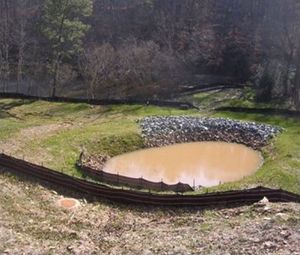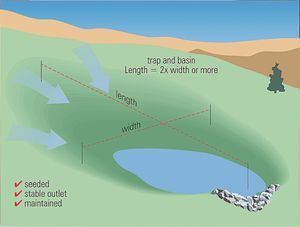
Sediment control practices - Sediment traps and basins
This section of the manual is being developed
Contents
Temporary/Permanent Sediment Traps and Basins
Sediment traps and basins are settling ponds formed by excavation and/or an embankment that intercept and retain sediment-laden runoff from a construction site for a sufficient period of time to allow the majority of sediment to settle out prior to being released from the site. They may be constructed as smaller sediment traps – serving disturbed areas of an acre or less – or as larger sediment basins, handling runoff from subdivisions, commercial/institutional sites, or roadway projects. Proper use of these structures can greatly reduce sediment transport off-site; if properly designed, installed, and maintained, sediment removal efficiency of 80% or greater can be achieved. Sediment traps are often temporary, and usually decommissioned after the disturbed area is stabilized (i.e., with vegetation or other cover). Temporary sediment basins can be converted to permanent stormwater management basins after construction is complete. Sediment traps and basins are very useful on construction sites with moderate to steep slopes, and the selection of traps versus basins primarily depends on the size of the contributing drainage area and plans for post-construction stormwater management, as discussed below.
Purpose and function
Sediment traps retain runoff using embankments and other barriers and discharge through an overflow or piped outlet to a vegetated swale or other drainage feature. Sediment basins are typically larger than sediment traps and may feature earthen embankments that retain runoff for longer periods of time, releasing runoff via floating, perforated, or slotted risers, or when the water level exceeds the height of the riser pipe in the outlet structure.
Applicability
Sediment traps and basins represent one of the most effective and reliable measures for treating sediment-laden runoff from construction sites. These structures are typically placed near the perimeter of the site, where flows concentrate in swales, ditches, or other low areas. Phasing of construction activities should be designed to allow sediment traps and basins to be utilized before upslope areas are disturbed, if possible, and until the contributing drainage area is fully stabilized. Specific considerations related to site applicability and permit applicability are discussed below.
Site applicability
Disturbed soils on a construction site have the potential to leave the site via stormwater runoff and negatively impact bodies of water, roadways, and neighboring property. Therefore, sediment traps and basins should be placed in such a way that they interrupt concentrated or sheet flows of stormwater discharge across a construction site. Sediment traps can be placed near the point of discharge and are often built in series to intercept and treat flow moving down long drainage paths through a site. Stormwater basins should be placed in low lying areas on the outer edge of a construction site where water naturally flows or is directed according to site plans. Sediment traps are extremely useful in perimeter control areas where silt fences will likely fail. Do not site sediment traps in high-velocity flow areas (e.g., culvert outlets, steep ditches) where excessive turbulence and scour erosion may interfere with sediment settling processes. Neither practice should be placed in surface waters (including intermittent streams) or within their required buffer zones.
Permit applicability
Section 14 (Temporary Sediment Basins) of the MPCA Construction Stormwater General Permit (2018) has several requirements regarding sediment basins, including:
- (Section 14.2) Sediment basins are required where ten (10) or more acres of disturbed soil drain to a common location. If the acreage of disturbed soil is reduced to less than ten (10) acres due to establishment of permanent cover, the temporary basin is no longer required. Temporary sediment basins may be converted to permanent basins after completion of construction.
- (Sections 14.3 and 14.4) For each acre of land that drains to the basin, the basin must provide sufficient live storage to hold runoff from a 2-year 24-hour storm event or provide 1,800 cubic feet of live storage, whichever is greater. If storm calculations are not conducted, the temporary basin must provide 3,600 cubic feet of storage for every acre drained.
- (Sections 14.5, 14.6, and 14.7) Outlet structures must be designed to prevent short-circuiting and discharge of floating debris, withdraw water from the surface of the sediment pond, and have sufficient energy dissipation for the outlet within 24 hours after connecting to a surface water.
- (Sections 14.8 and 14.9) Temporary basins must be located outside of surface waters and applicable buffer zone requirements, and temporary basins must be constructed prior to disturbance of ten (10) or more acres of soil draining to a common location.
- (Section 14.10) The general construction permit allows other effective sediment controls (e.g., a series of smaller sediment basins and/or sediment traps, silt fences, vegetative buffer strips, etc.) if sediment basin requirements are infeasible to meet on a particular site. This determination must be documented in the SWPPP.
Specific permit language
Applicability
Specifically, Section 14.2 of the MPCA Construction Stormwater General Permit (2018) states: “Where ten (10) or more acres of disturbed soil drain to a common location, permittees must provide a temporary sediment basin to provide treatment of the runoff before it leaves the construction site or enters surface waters. Permittees may convert a temporary sediment basin to a permanent basin after construction is complete. The temporary basin is no longer required when permanent cover has reduced the acreage of disturbed soil to less than ten (10) acres draining to a common location. “
Sizing
Section 14.3 states: “The temporary basin must provide live storage for a calculated volume of runoff from a two (2)-year, 24-hour storm from each acre drained to the basin or 1,800 cubic feet of live storage per acre drained, whichever is greater.”
Section 14.4 states: “Where permittees have not calculated the two (2)-year, 24-hour storm runoff amount, the temporary basin must provide 3,600 cubic feet of live storage per acre of the basins' drainage area”.
Outlets
Section 14.5 states: “Permittees must design basin outlets to prevent short-circuiting and the discharge of floating debris.”
Section 14.6 states: “Permittees must design the outlet structure to withdraw water from the surface to minimize the discharge of pollutants. Permittees may temporarily suspend the use of a surface withdrawal mechanism during frozen conditions. The basin must include a stabilized emergency overflow to prevent failure of pond integrity.”
Section 14.7 states: “Permittees must provide energy dissipation for the basin outlet within 24 hours after connection to a surface water.”
Location and timing
Section 14.8 states: “Permittees must locate temporary basins outside of surface waters and any buffer zone required in item 23.11 [of the general permit].”
Section 14.9 states: “Permittees must construct the temporary basins prior to disturbing 10 or more acres of soil draining to a common location.”
Alternatives
Section 14.10 states: “Where a temporary sediment basin meeting the requirements of item 14.3 through 14.9 is infeasible, permittees must install effective sediment controls such as smaller sediment basins and/or sediment traps, silt fences, vegetative buffer strips or any appropriate combination of measures as dictated by individual site conditions. In determining whether installing a sediment basin is infeasible, permittees must consider public safety and may consider factors such as site soils, slope, and available area on-site. Permittees must document this determination of infeasibility in the SWPPP”.
Additional information on basin drainage is provided in “Dewatering practices.” <MPCA, this should be linked to the Dewatering Practices wiki page>
Effectiveness
When designed, installed, and maintained properly, sediment traps and basins have relatively good sediment-trapping efficiencies (typically between 60 and 80%) and need little maintenance compared to other practices used to treat sediment-laden runoff as long as upland areas are brought to final grade and stabilized promptly. Sediment traps and basins provide good control of coarse sediment and are moderately effective for trapping medium-size sediment particles. However, they have a relatively low trapping efficiency for fine silt and clay particles suspended in runoff. Longer detention times, use of a flocculant, or additional sediment control measures may be necessary for their removal. In general, the larger the storage volume and the longer the detention time of the stormwater, the more efficient sediment basins are at removing finer particles. Oil, grease, and other floatables may also be removed if an outlet pipe is used that features perforated openings, a screen, a skimmer, or other means to draw ponded water from just below the surface. Effectiveness in removing floatables is completely dependent on the outlet design.


